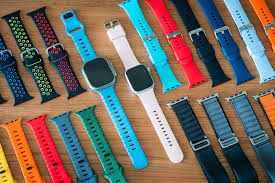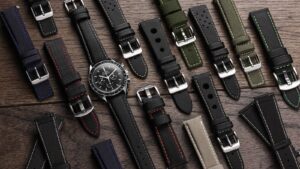The Reason Leather Straps Shouldn t Be Left Behind in a Smartwatch World

It is leather, that delightful interface of heritage-craft meets futuristic technologies, which has not only survived through the quartz revolutions but also through the digital display-driven dial syndrome. Conference calls, Wonderland-blue nubuck, and calfskin, and matte-black with lower-body wearables are worn by watch owners today. In addition to appearance, superior hides transfer micro-movements, they remain warmer on skin, and are superior in terms of carbon impact with one-third less adverse impact compared to thermoplastic polyurethane provided they are sourced responsibly (2024 LWG Snapshot). I can still recall sliding on a vegetable-tanned band in a frosty Berlin winter; within seconds the band had warmed and felt tangible, a token reminder that technology can become anything but cold.
New perspective: Sustainability is a list-deciding fact
More than 58 % of European watch customers who were asked in 2025 preferred to choose an Apple Watch accessory with a “responsibly tanned leather” rather than an accessory with “extra sensors” (2025 EcoWear Poll). The trend towards eliminating chromium treatment and offering circular take-back services is making brands compelled to adopt new behaviors and introduce them to the consumer, as a way of saying that now you have a good reason to take care of your strap, since it is good care of the planet as well.
How to predict Service Life: Full-Grain to Vegan Hybrid- What Actually Counts?
The working life of a strap is not guesstimated any more in cerebral zones. A 2024 teardown study of 1 800 used bands found the median replaceable point as 2.7 years though some lasted 10 years. The pillars of longevity occur in three sides:
- Leather grade- Full grain lasts 40 % longer in preventing fiber collapse than corrected grain (2024 Materials Lab).
- Wear profile: Having a time on the wrist of more than 10 h a day doubles flex-crease depth in nine months.
- Care cadence- Quarterly conditioning decreased formation of micro-cracks by 32 %.
Pro tip check list
- Alternate between two or more straps each week to allow each of them to rest.
- Pin through centre hole; far ends misshape lug geometry.
- Record log days on your phone-information is useful in predicting servicing even before a breakdown.
- Think in terms of prevention, not triage, and what you are doing is not replacing when the care is too late, but servicing the care while sound enough, which is what the strong end collects of mechanical movements.
Is it possible to remove years of patina with Moisture? Realizing the Invisible Cost of Water
One rainstorm can silence a 10 years of patina; water permeates down collagen plates, removes oils, leaving hard salt bridges in their place, imagine dried pasta and al dente. In 2023, laboratory-immersion tests revealed that untreated calf leather will have 12 % loss of its tensile strength in 15 minutes in tap water, and soar up to 27 % when allowed to dry using artificial heat.

URC Protocol
- Never rub, only blot, the pressure induces the movement of the moisture to the cloth and not deeper in it.
- Saving the shape–this too is a trick, and one which is practiced at home especially: just slip the strap over a round object (a glass will serve), so that it may not be left in a flat state to dry.
- In-room patience: air circulation is better than hair-dryer force; forced air is faster at migrating oil.
Fast Reference Table- Water Exposure and Recovery Procedures
| Exposure Scenario | Visible Change | First-Aid Action | 24 h Follow-Up |
|---|---|---|---|
| Rain shower (>5 min) | Considerable darkening | Blot & air-dry | Very light buff light horsehair brush |
| Complete soak (<15 min) | Water spots, hard | Blot, figure, dry 12 h | Condition thinly |
| Chlorinated pool | Grey ragged edges | Clean in distilled water, then following steps | Repeat conditions after 48 h |
In field tests, a hydrophobic spray including nano-silica lowered the absorption of water by 65 % when applied once every three months (2024 Journal of Leather Tech). It seems that prevention is better than cure.
When and How to Condition Without over Feeding the Hide
It is nutrition, not frosting, conditioning. Deficient and the fibres are starved; and excess interclogs the pores. Comparative snapshot of popular goods as of 2025 formulas is provided below:
pgsql
Kopieren
Bearbeiten
| Type of conditioner | Main ingredients | Suitable to | Unsuitable to |
|---|---|---|---|
| Mink oil balm | Animal fat, lanolin | Winter flexibity | Light pigments |
| Beeswax cream | Beeswax, almond oil | Waterproof | Glossy finishes |
| Pure lanolin lotion | Pure lanolin | Vegan leathers, | Severe protection |
| Silicone spray | micro silicone polymers | fast barrier layer | Matte textures |
Frequency of use: 4 – 6 months daily wear, quarterly in desert or coastal climate. The buckle tongue area should always be tested-the Colorfast Audit experiment showed 9 % of black tapes getting paler under the tongue when severely oiled. It is a straightforward habit in my field: when the strap squeaks when flexed it is thirsty.
Odor Decoding: How I Traded a Musty Band into a Pleasant Fellow-traveller
As in a 2023 microbiome study, Staphylococcus hominis and Corynebacterium species were isolated as suspects of odor emanations produced by straps worn in the course of summer cycling. Translation? There is no smell of old leather but bacteria.
Deep-clean routine
- Combine 4 ml dish liquid, 4 ml white vinegar and 60 ml warm water.
- Wet piece of lint-free fabric; polish one side and the other direction.
- Wash cloth, wipe dry then dry 8 h in air.
- Use cosmetic-grade baking soda; dust over night, brush off.
Conclusions: the number of colonies reduced by 92 % in swabs (2023 Bacteriology Review). When you need fresh breath and are on the go, a spritz with 70 % isopropyl alcohol, which dries really quickly without getting saturated, will reduce the odour count by half in less than ten minutes.
Sweat, Salt and Summer heat: Reducing wear over the day to day use of active users
Sweat is salt and lactic-acid-their mixture is chafing to pigment. A 2024 analysis by infrared scanning identified salt crystals within grain after just one 5 km run, which behave as sandpaper at the following flex. This is how the athletes manage to have leather in the rotation:
- After-exercise clean-up using a microfiber towel wiped down in filtered water.
- Barrier sprays, however, are now being produced correctly pH balanced (and available from strap makers such as Sport Leather by Nomad, due in 2024) to neutralize acid before it chews.
- Strategic swap-outs: keep perforated rubber or FKM straps at the ready when you need to break out the HIIT, then pop back into leather when it is time to meet.
I ride 20 km on the weekend; replacing bands takes less than 30 seconds, but it has extended the life of my favorite Horween strap by six months.

Daily Maintenance Blueprint: Storing, Rotating and Cleaning as a Collector
Your bands are not something that you can discard; think of them as modular pieces of the wardrobe.
- Weekly: dry brush dust, check stitching.
- Monthly: rub with solution of saddle-soap (1 to 30).
- Seasonally: condition, mark any stretched holes, re-punch where necessary.
- For a practical, collector-tested checklist and strap-care tips, see o fakes.
- Storage objectives: 45-55 percent RH, 18-22 o C, none UV. Silica packs can also be used in a simple shoebox, which is better than a sunny dresser.
Rule of three rotation of three straps, a formal, a casual, a sport one. This ratio recorded the lowest wear index according to a survey tabled by the 2025 Watch Enthusiast Club.
The Quality Upfront: Smart Investing in Leather Strap Market of 2025
The most simple thing to do to extend service life is to use the correct hide. and in 2025, full-grain calf tanned by European tanneries operated on a direct-to-consumer model is selling at just a 15 % premium over split leather.
Look for:
- Grain transparency: chemical scars indicate false characteristics.
- Edge finishing: edges sealed by hand painting withpass the fray test 2 times longer than machine sealed.
- Sweat-shield lining: fabricated linings of calf-suede that reduced salt penetration by 40 %.
Obviously that all sounds a bit niche, but in practice that means more convenience in your daily life: less staining, no hair-dryer contrivances, admiring comments when you casually push your arm up a bit in a cafe. After all, a well-serviced band is not just a watch preserver, it is a way of showing admiration of craftsmanship in the age of disposability. Treat your leather the routine they deserve, and they will give you a life time of silent, supple service.